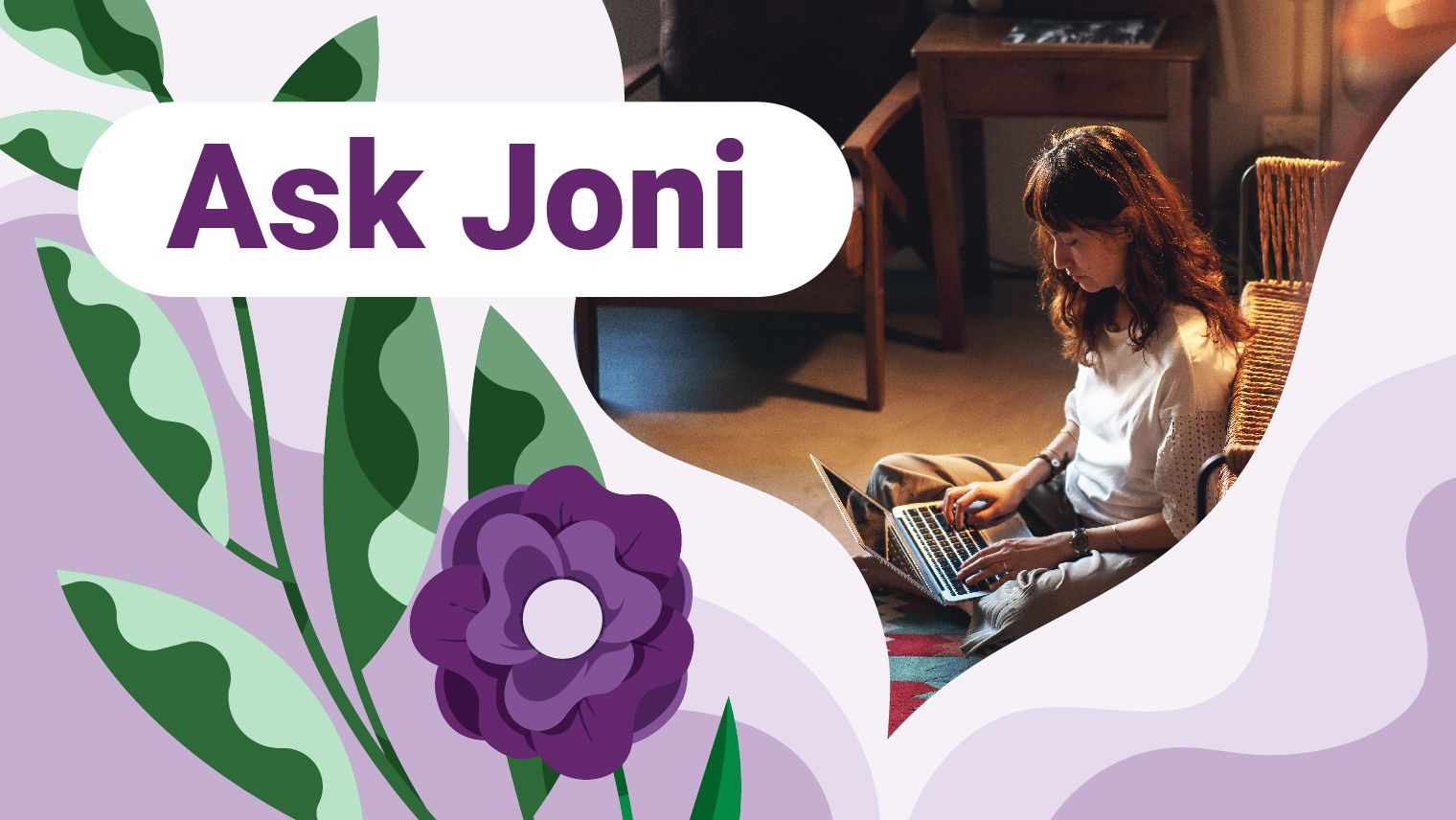Ask Joni: How Can I Manage Scalp Psoriasis?
July 27, 2022
Content created for the Bezzy community and sponsored by our partners. Learn More

Collage design by Ryan Hamsher
Scalp psoriasis can be uncomfortable and difficult to treat. Here are tips that have helped me cope.
Welcome to Ask Joni, an advice column by Joni Kazantzis, the community guide for Bezzy Psoriasis. Joni has lived with psoriasis for over 25 years and is passionate about sharing what she has learned with others. In her column, Joni answer questions sourced directly from community members. To have your questions answered join one of Joni’s nightly live discussions.
“My scalp psoriasis has been getting worse recently, is there anything I can do to manage my symptoms?” — Bezzy Psoriasis community member
Scalp psoriasis have you scratching your head? You’re definitely not alone.
Scalp psoriasis is a common, yet frustrating, symptom of a psoriasis flare. In addition to being on the scalp, plaques can appear on the hairline, forehead, back of the neck, and around your ears.
Having psoriasis plaques on your scalp and nearby areas can be uncomfortable. Scalp psoriasis can also be hard to treat, which can make it particularly distressing.
The good news is that there are many options for treating scalp psoriasis including oral retinoids, methotrexate, biologic therapy, and ultraviolet (UV) light therapy.
If you experience scalp psoriasis, it’s a good idea to talk with your doctor. Your doctor will be able to help you figure out what treatments may work for you.
If you’re looking for ways to find relief at home, read on for some tips I’ve learned while trying to soothe scalp psoriasis symptoms.


Scalp psoriasis is uncomfortable
Part of the discomfort of scalp psoriasis comes from the physical psoriasis symptoms. The plaques are typically dry and itchy. They can also be sore, cracked, or bleeding, depending on the severity.
Severity can vary from person to person. Over the course of a single flare, severity can fluctuate from mild discomfort to severe itching or pain.
In some severe cases, scalp psoriasis can cause hair loss if the plaques become too thick for the hair to grow through. Scratching or picking at plaques may also cause hair to come out.
The itching can also be incredibly uncomfortable. The tempting solution is to scratch, but that only provides temporary relief and will ultimately make it worse.
If you feel the urge to scratch, I find that keeping my nails cut short helps ensure that if I do scratch, I can’t do as much damage to the plaques.
Try a soothing mask
Oil masks can help combat thick plaques because they can help soften and keep the spots from getting too dry. Coconut oil can be gently massaged onto your scalp and left for about 20 minutes. After, make sure to rinse your hair thoroughly.
You can also gently run a wide tooth comb through your hair to remove scales from your hair.
Sometimes, I keep the coconut oil mask on overnight and wash it out in the morning with a tar shampoo. The lauric acid found in coconut oil is believed to help ease psoriasis symptoms because it’s highly moisturizing and may have anti-inflammatory properties. Once applied, I keep my hair in a bun while I sleep.
Baking soda may also help ease an itchy scalp. Try mixing 1 tablespoon of baking soda with water and applying the mixture over the affected plaques. This simple mixture is believed to reduce inflammation and soothe itchiness.
Shampoo treatments can be hit-or-miss
Many scalp psoriasis treatments are shampoos. I’ve found that shampoo-like treatments often don’t have enough time to soak into the affected spots before they get rinsed out.
I’ve found that treatments work better if they have an applicator tip so they can be applied directly on my plaques. If the treatment bottle doesn’t have an applicator tip, you can purchase one at a beauty store or online.
I’ve also found that treatments that are meant to be left on for longer periods of time work best for me.
Scalp sunburns can also cause a flare. Scalps are a very overlooked place to apply sunscreen. In small doses, the sun can be beneficial to psoriasis, but sunburns can cause a flare or can worsen current flares.
Cosmetic aspects of scalp psoriasis can be distressing
Scalp psoriasis can also cause white, scaly flakes that look like dandruff symptoms. This, along with hair loss has often led me to feel embarrassed or distressed.
I’ve found that selecting certain clothing styles and accessories can also help distract me from a flare and make me feel more comfortable.
For comfort, loose styles made from soft materials are your best option.
Wearing lighter colors can also help camouflage any flakes that fall onto your clothing. Accessories, like hats, headbands, or scarves, are another great way to cover up flakes and plaques.
Vitamins and supplements may help
In addition to topical scalp treatments, supplements may help treat scalp psoriasis symptoms.
Vitamin A, vitamin C, vitamin D, and vitamin E may each help lessen the severity of psoriasis symptoms. In addition to my biologic medication, I take turmeric, omega-3 fatty acid, and Oregon grape supplements.
Before starting any new supplements, speak with your doctor.
The bottom line
Even with medications and treatments, it can take time for things to work. It can take some trial and error to find the right combination of treatments that work for you.
Patience and persistence have helped me find comfort throughout my journey with scalp psoriasis.
Medically reviewed on July 27, 2022
7 Sources


Like the story? React, bookmark, or share below:
Have thoughts or suggestions about this article? Email us at article-feedback@bezzy.com.
About the author